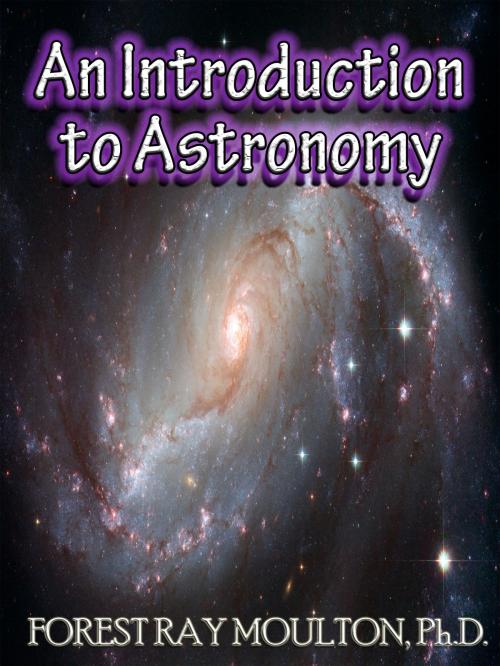An Introduction to Astronomy - Take a Journey from Earth to the Moon, from the Sun to the Planets, to the Universe and Beyond
Nonfiction, Science & Nature, Science, Physics, Cosmology, Astronomy, Astrophysics & Space Science| Author: | Forest Ray Moulton, Ph.D. | ISBN: | 1230000128126 |
| Publisher: | Moulton | Publication: | April 27, 2013 |
| Imprint: | Language: | English |
| Author: | Forest Ray Moulton, Ph.D. |
| ISBN: | 1230000128126 |
| Publisher: | Moulton |
| Publication: | April 27, 2013 |
| Imprint: | |
| Language: | English |
An Introduction to Astronomy by F.R. Moulton - The definitive text for learning about the amazing science of Astronomy.
The progress of mankind has been marked by a number of great intellectual movements. At one time the ideas of men were expanding with the knowledge which they were obtaining from the voyages of Columbus, Magellan, and the long list of hardy explorers who first visited the remote parts of the earth. At another, millions of men laid down their lives in order that they might obtain toleration in religious beliefs. At another, the struggle was for political freedom. It is to be noted with satisfaction that those movements which have involved the great mass of people, from the highest to the lowest, have led to results which have not been lost.
The present age is known as the age of science. Never before have so many men been actively engaged in the pursuit of science, and never before have its results contributed so enormously to the ordinary affairs of life. If all its present-day applications were suddenly and for a considerable time removed, the results would be disastrous. With the stopping of trains and steamboats the food supply in cities would soon fail, and there would be no fuel with which to heat the buildings. Water could no longer be pumped, and devastating fires might follow. If people escaped to the country, they would perish in large numbers because without modern machinery not enough food could be raised to supply the population. In fact, the more the subject is considered, the more clearly it is seen that at the present time the lives of civilized men are in a thousand ways directly dependent on the things produced by science.
Astronomy is a science. That is, it is one of those subjects, such as physics, chemistry, geology, and biology, which have made the present age in very many respects altogether different from any earlier one. Indeed, it is the oldest science and the parent of a number of the others, and, in many respects, it is the most perfect one. For these reasons it illustrates most simply and clearly the characteristics of science. Consequently, when one enters on the study of astronomy he not only begins an acquaintance with a subject which has always been noted for its lofty and unselfish ideals, but, at the same time, he becomes familiar with the characteristics of the scientific movement.
CHAPTER I
Science
CHAPTER II
The Earth
The Shape of the Earth
The Mass of the Earth and the Condition of its Interior
The Earth’s Atmosphere
CHAPTER III
The Motions Of The Earth
The Rotation of the Earth
The Revolution of the Earth
CHAPTER IV
Reference Points and Lines
CHAPTER V
The Constellations
CHAPTER VI
Time
CHAPTER VII
The Moon
CHAPTER VIII
The Solar System
The Law of Gravitation
Orbits, Dimensions, and Masses of the Planets
CHAPTER IX
The Planets
Mercury and Venus
Mars
Jupiter
Saturn
Uranus and Neptune
CHAPTER X
Comets And Meteors
Comets
Meteors
CHAPTER XI
The Sun
The Sun’s Heat
Spectrum Analysis
The Constitution of the Sun
CHAPTER XII
Evolution Of The Solar System
General Considerations on Evolution
Data of Problem of Evolution of Solar System
The Planetesimal Theory
Historical Cosmogonies
CHAPTER XIII
The Sidereal Universe
The Apparent Distribution of the Stars
Distances and Motions of the Stars
The Stars
The Nebulæ
An Introduction to Astronomy by F.R. Moulton - The definitive text for learning about the amazing science of Astronomy.
The progress of mankind has been marked by a number of great intellectual movements. At one time the ideas of men were expanding with the knowledge which they were obtaining from the voyages of Columbus, Magellan, and the long list of hardy explorers who first visited the remote parts of the earth. At another, millions of men laid down their lives in order that they might obtain toleration in religious beliefs. At another, the struggle was for political freedom. It is to be noted with satisfaction that those movements which have involved the great mass of people, from the highest to the lowest, have led to results which have not been lost.
The present age is known as the age of science. Never before have so many men been actively engaged in the pursuit of science, and never before have its results contributed so enormously to the ordinary affairs of life. If all its present-day applications were suddenly and for a considerable time removed, the results would be disastrous. With the stopping of trains and steamboats the food supply in cities would soon fail, and there would be no fuel with which to heat the buildings. Water could no longer be pumped, and devastating fires might follow. If people escaped to the country, they would perish in large numbers because without modern machinery not enough food could be raised to supply the population. In fact, the more the subject is considered, the more clearly it is seen that at the present time the lives of civilized men are in a thousand ways directly dependent on the things produced by science.
Astronomy is a science. That is, it is one of those subjects, such as physics, chemistry, geology, and biology, which have made the present age in very many respects altogether different from any earlier one. Indeed, it is the oldest science and the parent of a number of the others, and, in many respects, it is the most perfect one. For these reasons it illustrates most simply and clearly the characteristics of science. Consequently, when one enters on the study of astronomy he not only begins an acquaintance with a subject which has always been noted for its lofty and unselfish ideals, but, at the same time, he becomes familiar with the characteristics of the scientific movement.
CHAPTER I
Science
CHAPTER II
The Earth
The Shape of the Earth
The Mass of the Earth and the Condition of its Interior
The Earth’s Atmosphere
CHAPTER III
The Motions Of The Earth
The Rotation of the Earth
The Revolution of the Earth
CHAPTER IV
Reference Points and Lines
CHAPTER V
The Constellations
CHAPTER VI
Time
CHAPTER VII
The Moon
CHAPTER VIII
The Solar System
The Law of Gravitation
Orbits, Dimensions, and Masses of the Planets
CHAPTER IX
The Planets
Mercury and Venus
Mars
Jupiter
Saturn
Uranus and Neptune
CHAPTER X
Comets And Meteors
Comets
Meteors
CHAPTER XI
The Sun
The Sun’s Heat
Spectrum Analysis
The Constitution of the Sun
CHAPTER XII
Evolution Of The Solar System
General Considerations on Evolution
Data of Problem of Evolution of Solar System
The Planetesimal Theory
Historical Cosmogonies
CHAPTER XIII
The Sidereal Universe
The Apparent Distribution of the Stars
Distances and Motions of the Stars
The Stars
The Nebulæ















